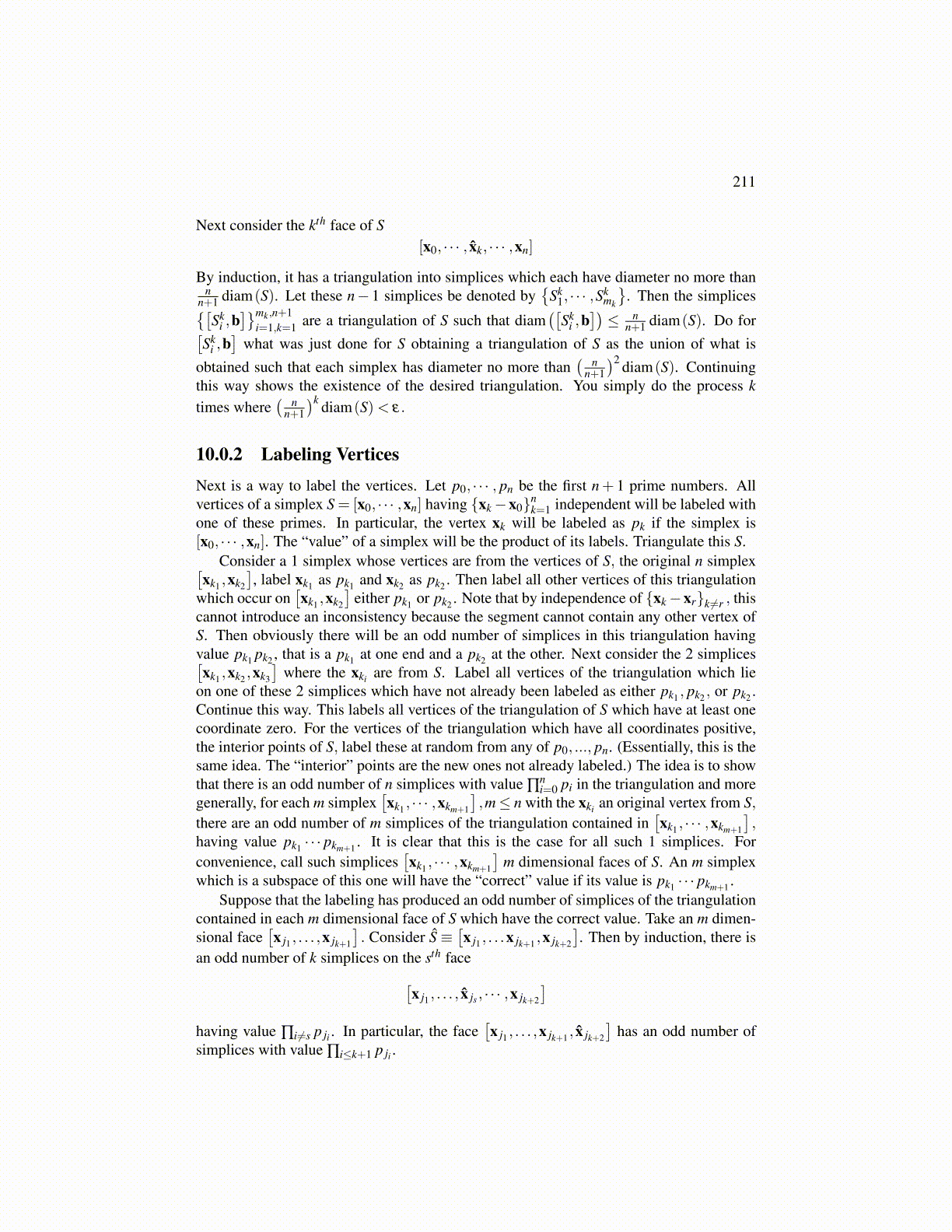
211
Next consider the kth face of S[x0, · · · , x̂k, · · · ,xn]
By induction, it has a triangulation into simplices which each have diameter no more thann
n+1 diam(S). Let these n− 1 simplices be denoted by{
Sk1, · · · ,Sk
mk
}. Then the simplices{[
Ski ,b]}mk,n+1
i=1,k=1 are a triangulation of S such that diam([
Ski ,b])≤ n
n+1 diam(S). Do for[Sk
i ,b]
what was just done for S obtaining a triangulation of S as the union of what is
obtained such that each simplex has diameter no more than( n
n+1
)2 diam(S). Continuingthis way shows the existence of the desired triangulation. You simply do the process ktimes where
( nn+1
)k diam(S)< ε.
10.0.2 Labeling Vertices
Next is a way to label the vertices. Let p0, · · · , pn be the first n+ 1 prime numbers. Allvertices of a simplex S = [x0, · · · ,xn] having {xk−x0}n
k=1 independent will be labeled withone of these primes. In particular, the vertex xk will be labeled as pk if the simplex is[x0, · · · ,xn]. The “value” of a simplex will be the product of its labels. Triangulate this S.
Consider a 1 simplex whose vertices are from the vertices of S, the original n simplex[xk1 ,xk2
], label xk1 as pk1 and xk2 as pk2 . Then label all other vertices of this triangulation
which occur on[xk1 ,xk2
]either pk1 or pk2 . Note that by independence of {xk−xr}k ̸=r , this
cannot introduce an inconsistency because the segment cannot contain any other vertex ofS. Then obviously there will be an odd number of simplices in this triangulation havingvalue pk1 pk2 , that is a pk1 at one end and a pk2 at the other. Next consider the 2 simplices[xk1 ,xk2 ,xk3
]where the xki are from S. Label all vertices of the triangulation which lie
on one of these 2 simplices which have not already been labeled as either pk1 , pk2 , or pk2 .Continue this way. This labels all vertices of the triangulation of S which have at least onecoordinate zero. For the vertices of the triangulation which have all coordinates positive,the interior points of S, label these at random from any of p0, ..., pn. (Essentially, this is thesame idea. The “interior” points are the new ones not already labeled.) The idea is to showthat there is an odd number of n simplices with value ∏
ni=0 pi in the triangulation and more
generally, for each m simplex[xk1 , · · · ,xkm+1
],m≤ n with the xki an original vertex from S,
there are an odd number of m simplices of the triangulation contained in[xk1 , · · · ,xkm+1
],
having value pk1 · · · pkm+1 . It is clear that this is the case for all such 1 simplices. Forconvenience, call such simplices
[xk1 , · · · ,xkm+1
]m dimensional faces of S. An m simplex
which is a subspace of this one will have the “correct” value if its value is pk1 · · · pkm+1 .Suppose that the labeling has produced an odd number of simplices of the triangulation
contained in each m dimensional face of S which have the correct value. Take an m dimen-sional face
[x j1 , . . . ,x jk+1
]. Consider Ŝ ≡
[x j1 , . . .x jk+1 ,x jk+2
]. Then by induction, there is
an odd number of k simplices on the sth face[x j1 , . . . , x̂ js , · · · ,x jk+2
]having value ∏i ̸=s p ji . In particular, the face
[x j1 , . . . ,x jk+1 , x̂ jk+2
]has an odd number of
simplices with value ∏i≤k+1 p ji .